Recently, we shared our list of 7 Wonders of the Mormon World. But there are so many fascinating sites that we had to share 7 more!
Gadfield Elm Chapel
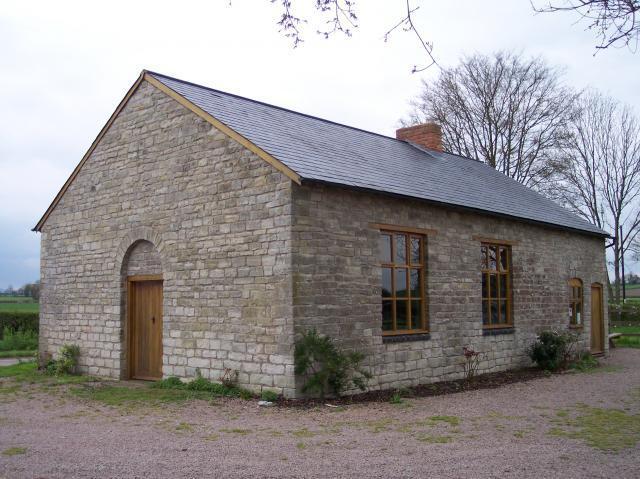
Photo by Bob Embleton
The Gadfield Elm Chapel, in Worcestershire, England, is the world's first and world's oldest surviving LDS chapel.
The chapel was built in 1836 by a Christian Methodist group called the United Brethren. In 1840, the building was deeded to Wilford Woodruff who accepted it on behalf of the Church. Several conferences were held at the chapel, and President Brigham Young preached there when it was the only LDS chapel in the world.
As Saints in England made their journey to the United States to be with their fellow Mormons, the chapel became unnecessary. The building was sold in 1842, and the money was used to help pay for the emigration of the Saints.
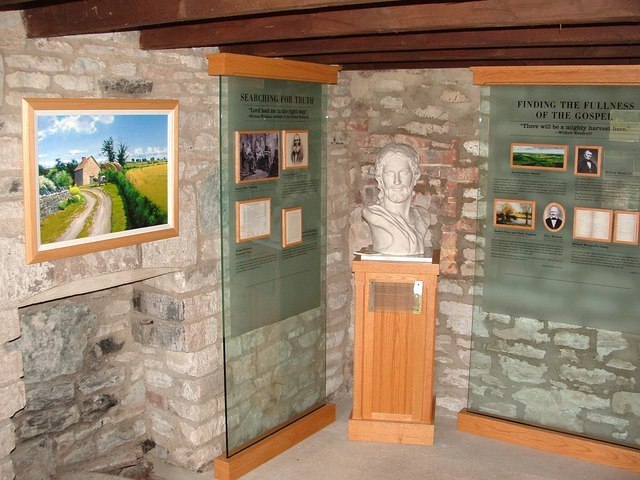
Photo by Bob Embleton
In 1994, a group of Church members privately acquired the chapel and began carefully restoring it to its original state. Elder Jeffrey R. Holland dedicated the chapel on April 23, 2000, and President Gordon B. Hinckley received the historic Gadfield Elm Chapel on behalf of the Church in May 2004.
Adam-ondi-Ahman
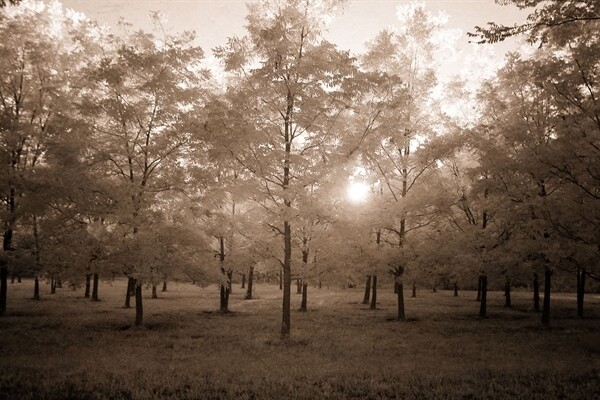
Photo by Robert A. Boyd
Adam-ondi-Ahman, a settlement located in Daviess County, Missouri, was revealed by the Prophet Joseph Smith to be the location where Adam lived after being expelled from the Garden of Eden (which the Prophet declared to be in Jackson County, Missouri).
Joseph Smith also revealed that three years before Adam's death, he gathered his posterity to Adam-ondi-Ahman to bestow upon them his last blessing. Furthermore, he said Adam-ondi-Ahman will be the location of a future meeting of the Lord with Adam and the Saints, as prophesied by Daniel (Dan. 7:9-14; 21-27; 12:1-3).
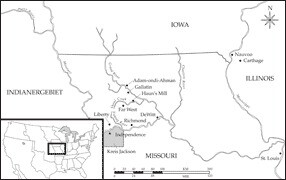
map from lds.org
In 1838, between 500 and 1,000 Saints lived in Adam-ondi-Ahman. On October 11 of that year, mobs forced the Saints from nearby DeWitt in Carroll County and then traveled to Daviess County where they burned the homes of Saints and stole their livestock. Church members throughout Daviess County congregated at Adam-ondi-Ahman for safety, though some retaliated in an attempt to defend themselves.
On November 7, 1838, the Missouri militia forced the Saints to surrender their arms and gave them 10 days to evacuate. The Saints abandoned Adam-ondi-Ahman, which then became the property of non-Mormon settlers.
In 1944, Wilford C. Wood purchased 38 acres at Adam-ondi-Ahman for the Church, and 3,000 more acres have since been purchased.
Polynesian Cultural Center
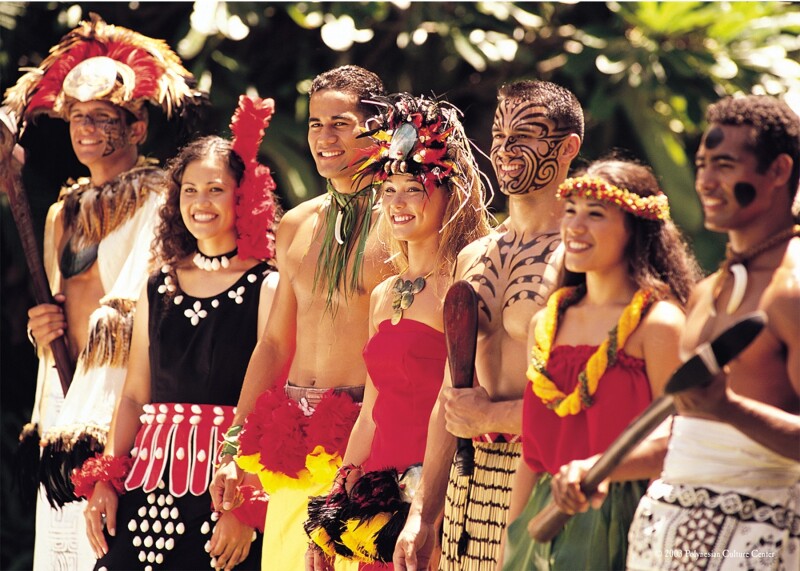
Photo courtesy of the Polynesian Cultural Center
The Church’s history in Polynesia dates almost as far back as the Church itself, beginning on May 11, 1843, when the Prophet Joseph Smith called missionaries to the South Pacific. (Missionaries reached French Polynesia, Hawaii, New Zealand, and Samoa in the mid-1800s and Tonga in 1891, but it would be more than 100 years before they established a presence in Fiji and Rapa Nui—1954 and 1980, respectively.)
In 1865, Brigham Young declared Oahu's town of Laie a “gathering place” for the Hawaiian Saints. With the completion of the Laie Hawaii Temple in 1919, even more islanders from throughout the South Pacific were drawn to the area. Then, during a visit to Laie in 1921, David O. McKay envisioned a school of higher learning to complement the new temple. Though it took decades to come to fruition, ground was broken for the Church College of Hawaii (known today as BYU–Hawaii) on February 12, 1955. In his dedicatory prayer, President McKay stated: “We dedicate our actions in this service unto thee and unto thy glory and to the salvation of the children of men, that this college, and the temple, and the town of Laie may become a missionary factor, influencing not thousands, not tens of thousands, but millions of people who will come seeking to know what this town and its significance are.”
But how would the remote community of Laie influence millions of people? The Polynesian Cultural Center would prove to be the answer to President McKay’s prophetic prayer.
In 1962, President McKay authorized the construction of the Polynesian Cultural Center with three goals in mind: preserve and share the cultures of Polynesia, provide financial assistance and employment to students at the Church College of Hawaii, and demonstrate a spirit of love and service to uplift all who visit the Center.
Since its opening, the PCC has had more than 37 million visitors, including several dignitaries and celebrities.
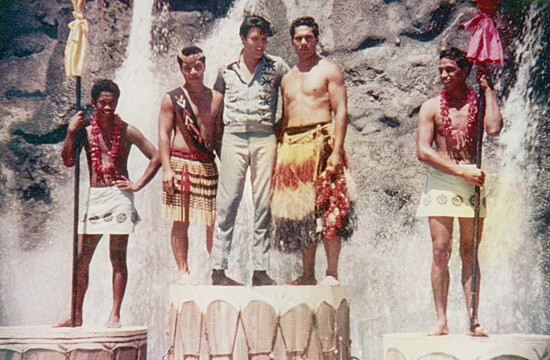
In 1966, Elvis Presley spent a week at the PCC filming portions of Paradise Hawaiian Style
(Photo courtesy of the Polynesian Cultural Center)
Part of the PCC experience includes their spectacular night show, Ha: The Breath of Life--the world's largest Polynesian revue. Click below to watch a preview.
Rome Italy Temple
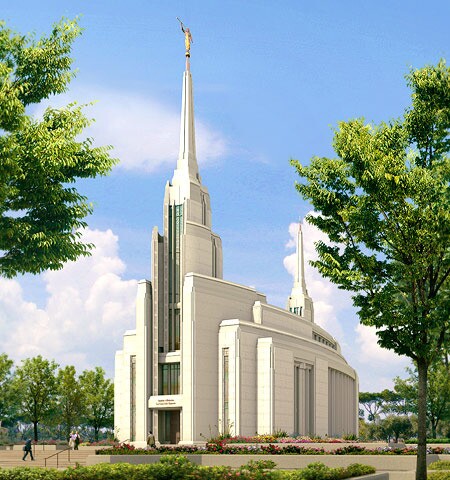
Image from mormonnewsroom.org
On October 4, 2008, President Monson's announcement that a temple would be built in Rome was met with gasps from general conference attendees and Church members around the world.
Ground was broken for the temple on October 23, 2010, and delighted Saints are closely following the progress of the temple's construction in the Eternal City where the Apostle Paul once walked and where Catholicism reigns supreme. (Click hereto read how Rome's religious leaders are reacting to the temple construction.)
The Rome Italy Temple is being built on 14.5 acres in the northeast corner of the city and will reach 156 feet, 3 inches once the statue of angel Moroni is in place.
The temple's floor and ceiling patterns are inspired by Michelangelo's Piazza del Campidoglio located at the top of the Capitoline Hill in Rome.
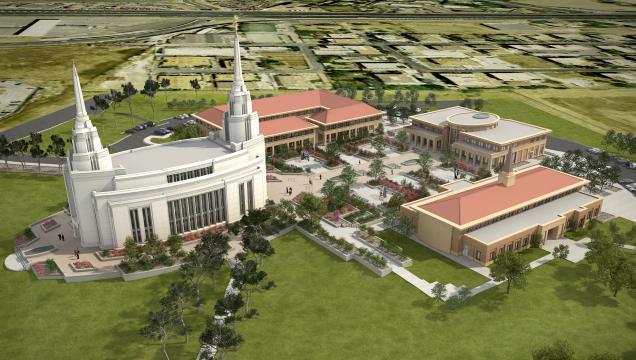
Image from mormonnewsroom.org
The Rome Italy Temple will be the crown jewel in a complex of LDS buildings that also includes a stake center, visitor's center, family history center, and lodging facility for temple workers and patrons traveling long distances.
No open house or dedication dates have been announced yet.
Carthage Jail
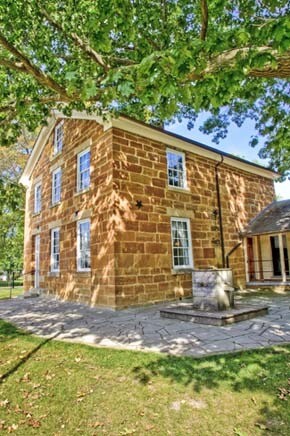
Photo from lds.org
Carthage Jail is where Joseph Smith and his brother Hyrum were martyred on June 27, 1844.
Joseph and Hyrum arrived at Carthage a few days earlier, on June 24, after the governor of Illinois promised them protection if they would turn themselves in and go to Carthage for trial. Even so, the Prophet famously stated that he was "going like a lamb to the slaughter."
A day after their arrival, Joseph and Hyrum were released on bail, only to be charged with treason. John Taylor and Dr. Willard Richards were not under arrest, but they chose to stay with the Prophet and his brother in the jail.
On June 27th, an armed mob stormed Carthage Jail. The four men tried to hold the door closed, but to no avail--Hyrum was quickly shot and killed.
In desperation, Joseph attempted to jump out a second-story window just as the mob forced their way into the room. The Prophet was shot four times--twice in the back and twice in the chest as he fell from the window. Despite also being shot four times, John Taylor survived. Dr. Willard Richards miraculously escaped without injury.
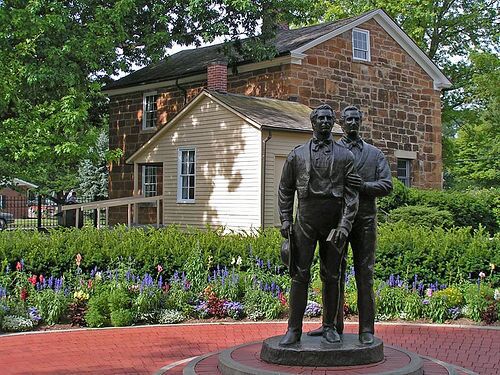
Photo from mormonwiki.com
Carthage Jail was later converted into a house and was privately owned until the Church purchased it in 1903 and then restored it in 1938. The restored site, which includes a bronze statue of Joseph and Hyrum Smith, was dedicated in 1989.
Gilgal Sculpture Garden
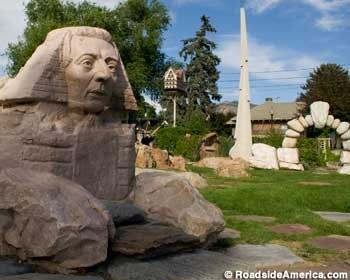
The Sphinx
Photo from roadsideamerica.com
In the heart of downtown Salt Lake City lies the mysterious and unique Gilgal Sculpture Garden--Church member Thomas Child's tribute to the scriptures and the restored gospel.
The word "Gilgal" means "circle of sacred stones"--an appropriate name for Child's garden, which contains 12 original sculptural arrangements and over 70 stones engraved with scriptures, poems, and philosophical texts.
Child began work on Gilgal Sculpture Garden in 1945 at age 57, when he had served as bishop of the same ward for more than 19 years. Child spent much of his time and resources working on the garden until his death in 1963. The following are explanations behind a few of Child's creations from gilgalgarden.org.
The Sphinx (photo above) represents Child's belief that the answers to life's great questions cannot be discovered with intellect, but only through faith. The sphinx is an ancient symbol of riddles and mystery. Joseph Smith's face symbolizes Child's belief that the restored priesthood reveals to mankind the answers to life's mysteries.
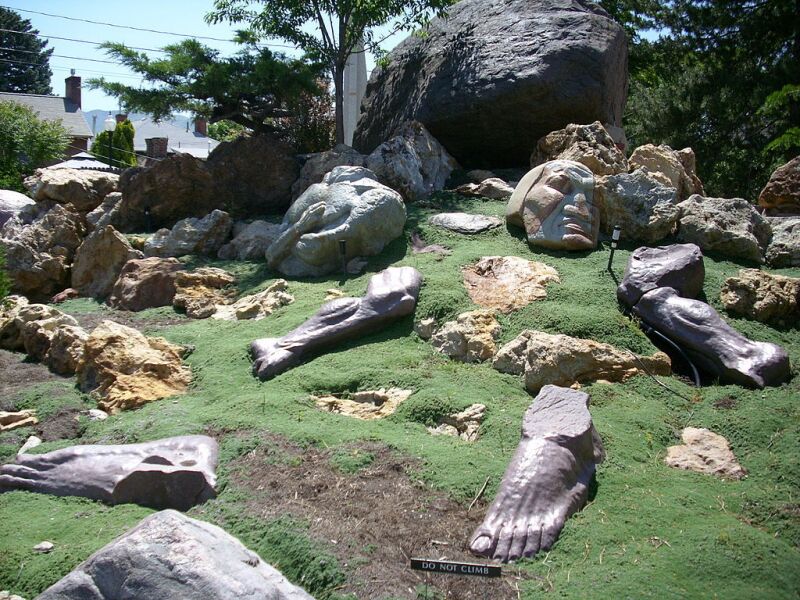
Daniel II: Nebuchadnezzar's Dream
Photo from Wikipedia
In this work, Child portrays the shattered giant from the Biblical story of King Nebuchadnezzar's dream. Nebuchadnezzar sees a great image with a head of gold, breast and arms of silver, belly and thighs of brass, legs of iron, and feet of iron and clay. The giant is destroyed by a "stone cut out of the mountain without hands" which becomes a great mountain and fills the whole earth.
The Hebrew wise man Daniel interpreted the dream to mean that successive kingdoms, represented by the different pieces of the giant, would rule the earth until the kingdom of God was established to rule forever. Child believed God's kingdom was begun with the founding of the LDS Church. Child spent over two years working on this monument.

The Last Chapter of the Book of Ecclesiastes
Photo from roadsideamerica.com
In this monument, Child represents several verses from the last chapter of the Book of Ecclesiastes in the Bible. It includes objects from the verse "...the almond tree shall flourish, and the grasshopper shall be a burden...the silver cord be loosed, or the golden bow be broken, or the pitcher be broken at the fountain, or the wheel broken at the cistern."
Child planted an almond tree on the mount as part of this monument. The tree grew and flourished despite Utah's cold winters. It died in 1963, the same year as Child died.
Child created the head of an old man to represent the first verses of this chapter which he interpreted as meaning, "In spite of ourselves, we get sick, weak, and die, and are not the masters of the situation."
Priesthood Restoration Site
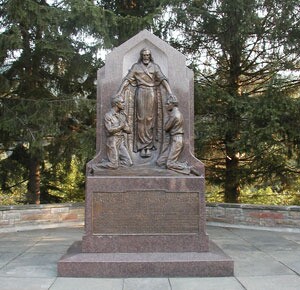
Photo from mormonhistoricsites.org
On May 15, 1829, the priesthood of God was restored to the earth near Harmony (now Oakland), Pennsylvania.
In April 1829, Oliver Cowdery became a scribe for Joseph Smith. While translating 3 Nephi, the Prophet and Oliver read about the importance of baptism and went to the woods to pray for direction. The resurrected John the Baptist appeared to them on May 15, 1829, and conferred upon them the Aaronic Priesthood. He then commanded Joseph and Oliver to baptize each other in the nearby Susquehanna River. He then commanded them to ordain each other.
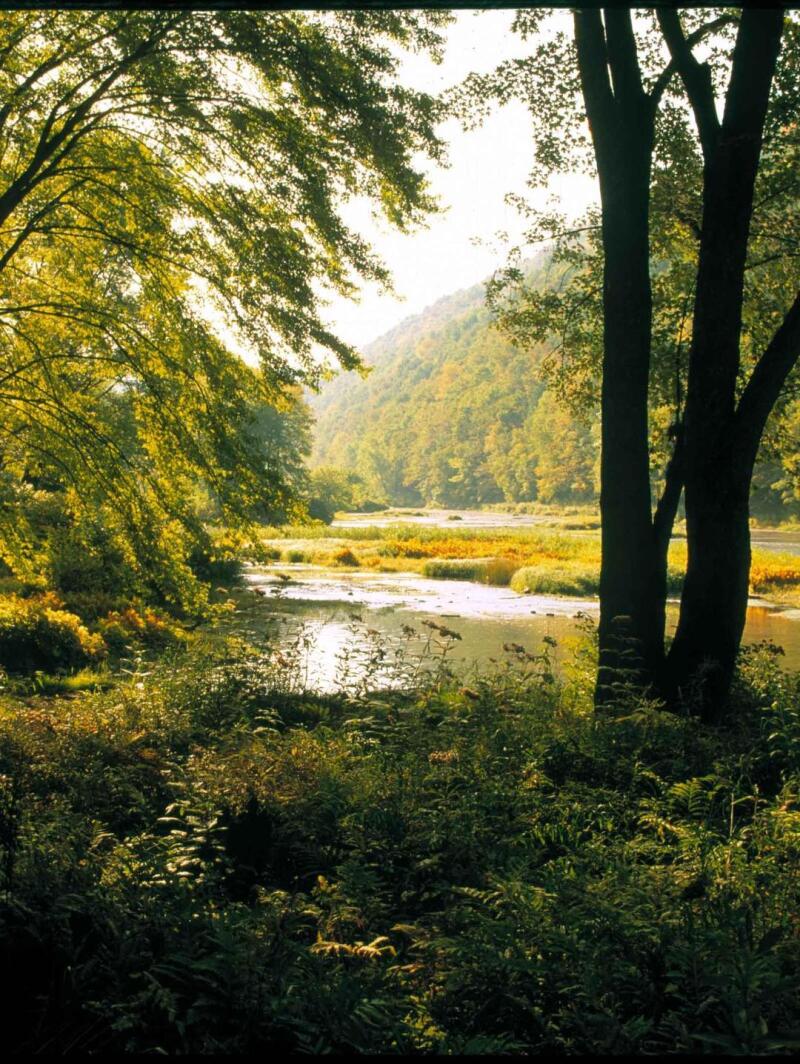
Photo from history.lds.org
Oliver recorded the following about the experience:
“I shall not attempt to paint to you the feelings of this heart, nor the majestic beauty and glory which surrounded us on this occasion; but you will believe me when I say, that earth, nor men, with the eloquence of time, cannot begin to clothe language in as interesting and sublime a manner as this holy personage. No; nor has this earth power to give the joy, to bestow the peace, or comprehend the wisdom which was contained in each sentence as they were delivered by the power of the Holy Spirit!” (Messenger and Advocate, Volume 1, (October 1834), 16.)
Soon afterward, the Melchizedek Priesthood was conferred upon Joseph and Oliver by Apostles Peter, James, and John. Although the exact date and location is not known, historical evidence suggests this happened between May 16 and May 28 of 1829.
Most of the Book of Mormon was translated at Harmony. And it was here that Joseph Smith received 15 revelations that would later be published in the Doctrine and Covenants.
In August 1830, Joseph and Emma left Harmony, and in 1919, the home they left behind burned down. From 1947 to 1959, the Church acquired the land where Joseph and Emma lived, as well as approximately 6 acres along the Susquehanna River where the Aaronic Priesthood was restored. The Church is recently restored the site, built a visitor's center, and produced a new Church history film that is shown at the center. It is the last site of the Restoration to be fully restored.
